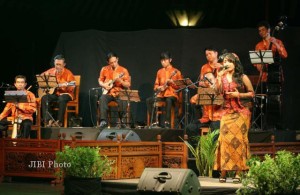Keroncong /kron´• chong/ (alternatively spelled “kroncong”) is a traditional string-band music of Indonesia.
History
Imagine the music and instruments that might have accompanied Portuguese explorers, conquistadors, and merchants and their indentured maritime laborers from Africa and India during Europe’s period of expanding contact with Asia and its outlying islands in the 1500s. For the first time ever, Western harmony and bowed strings were filtered through sophisticated Javanese, African and Indian rhythms creating new hybrids. This is the presumed origin of kroncong, though evidence of the early history is scarce.
Over time it was adapted to the tastes of the Dutch ruling class and became a dominant form of music in Indonesia as it entered popular theatre. In the early 20th century it was propagated by Chinese record labels in search of profitable material. It experienced a resurgence as Japanese imperial occupiers, seeking to expunge all Western influence, promoted local traditional cultures in their territories. Keroncong assumed a nationalist tone during Indonesia’s struggle for independence; the lyrics of many keroncong standards still reflect those themes. It has even influenced gamelan, as repertoire moves freely across genres. Eventually it was sidelined by modern international pop music, and persists now primarily as a nostalgic “old-time” tradition.
[Philip Yampolsky, et al. “Pan-Indonesian musical developments.” Indonesia. Grove Music Online. Oxford Music Online. Oxford University Press, accessed July 8, 2016]
It is, however, a living tradition, frequently hybridized with jazz, modern pop music, and even Brazilian samba. We play primarily langgam kroncong, kroncong asli, and langgam jawa kroncong, which are older traditional styles favored by the ensembles we admire.
Study
We are learning kroncong music partly through musicological research and direct imitation of the following Javanese OK (orkes kroncong) ensembles:
OK Semar Mesem
- Pak Edi Slameto – flute
- Pak Budiyono – bass
- Pak Tukiyo (and Pak Aden) – guitar
- Pak Agus – cak
- Pak Gianto – cuk
- Pak Slamet Kepek – cello
- Pak Basuno – violin
- Pak Pedro – vocal
- Pak Julius Giri Haryanto – violin
- Pak Aden Riyanto – bass
- Pak Tutuk Muryoko – cak
- Pak Taufik Haryanto (Yansol) – cuk
- Pak Sugiarto – cello
- Pak Ipoeng Purjanto (Cipluk) – guitar
- Pak Dwijaya Syaifil Munir – vocal and coordinator
- Pak Danis Sugiyanto – cak
- Pak Sapto Haryono – flute
- Pak Agung Suprapto – guitar
- Pak Didik Paidin – bass
- Pak Martanto – cuk
- Pak Sipur – cello
- Bu Yantie Sapto – vocal
Practice

The selo (a modified cello) is played somewhat like a pizzicato bass, though a trained ear will discern that it is actually playing Javanese drum patterns. The bass is also plucked, but keeps to the root of each chord, and typically plays only one whole note per measure. “Keroncong” is also the generic name for two small 3-stringed guitars called cuk and cak. The cak is played primarily in ostinato 4-note picking patterns that elaborate the chords like a siter (zither) figure from gamelan music, while the cuk patterns resemble patterns performed on the kenong, kethuk and kempyang. Both are occasionally strummed like a flamenco guitar of the Iberian peninsula.
The guitar, flute, and violin all retain standard Western tunings. The flute and violin play lyrical improvisations during vocal breaks, intros, and outros. The guitar does too, though its primary function is non-stop improvised modal melodies in the manner of the Javanese gambang xylophone.
Singers — typically female — sing in a florid style that traces wide-ranging melodies with a free rhythm.
Like gamelan, keroncong features dramatic tempo changes, and often when the tempo slows down, the density of notes doubles, producing a paradoxical effect that feels simultaneously like tension and relaxation — a rhythmic analogy for contrary motion in Western harmony.